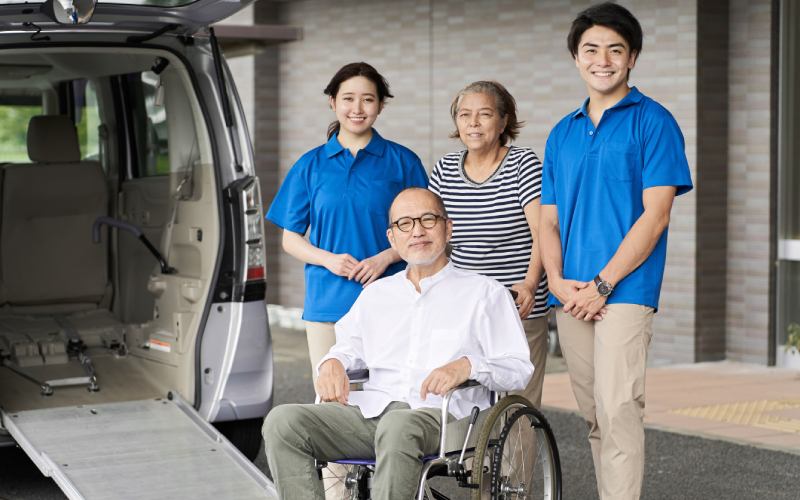Benefits of Utilizing Senior Transportation Services
Understanding the benefits of senior transportation services is vital for those in need of non-medical in-home care. Let’s explore how these services can enhance independence and ensure the safety of seniors.
Enhancing Independence through Safe Transportation
Reliable transportation services for seniors play a pivotal role in maintaining their independence. By providing access to safe and dependable rides, these services allow seniors to attend medical appointments, grocery shopping, and social activities without the need to rely on family members or friends for transportation. This independence is crucial for their mental and emotional well-being.
| Benefit | Description |
|---|---|
| Medical Appointments | Allows seniors to keep regular medical appointments, ensuring their health is monitored consistently. |
| Social Engagement | Facilitates social activities that are essential for mental health and preventing feelings of isolation. |
| Routine Tasks | Enables seniors to manage daily tasks such as grocery shopping, maintaining their autonomy. |
For those seeking comprehensive care, our article on how non-medical home care promotes senior independence provides further insights.
Access to Affordable and Convenient Rides
Senior transportation services often offer affordable and convenient ride options that can fit within a budget. This affordability ensures that even those on a fixed income can take advantage of these essential services.
*Cost estimates are approximate. **Reduced fare for seniors and individuals with disabilities.
To understand how these services can enhance seniors’ quality of life, explore our guide on affordable home care options in Sacramento and Elk Grove.
Importance of Regular Eye Examinations
Regular eye examinations are critical for seniors who drive. Ensuring that vision issues are addressed can significantly impact driving safety. Eye exams can determine if new lenses or glasses are required, helping maintain sharp vision and reducing the risk of accidents (Comfort Keepers).
For more details on maintaining senior health and independence, visit our articles on how activities of daily living (ADLs) keep seniors independent and instrumental activities of daily living (iADLs): improving quality of life for seniors.
Utilizing senior transportation services not only enhances independence but also ensures that seniors can live a safe and active life. For personalized in-home care and support, see our article on how Bravo Personal Care services ensures quality care for seniors.
Key Considerations for Senior Mobility
Ensuring safe and efficient transportation for seniors involves multiple aspects, from physical health to the technology in their vehicles. Below we discuss some key considerations for enhancing senior mobility.
Role of Daily Exercise in Driving Abilities
Daily exercise plays a pivotal role in maintaining and improving driving skills among seniors. Activities that focus on strength, flexibility, and cardiovascular health can significantly aid in steering control, assessing traffic, and managing long drives. Notably, engaging in exercises like walking, swimming, and yoga can help improve overall mobility and reduce the risk of accidents.
| Exercise Type | Benefits for Driving |
|---|---|
| Walking | Improves cardiovascular health and leg strength |
| Swimming | Enhances overall body strength and flexibility |
| Yoga | Increases flexibility and reduces stress |
Additionally, regular physical activity is strongly linked to better mental health, which is crucial for making quick decisions on the road. For a more comprehensive look at how daily exercises support senior independence, refer to our article on how activities of daily living (ADLs) keep seniors independent.
Utilizing Hearing Aids for Improved Driving
Hearing is an essential sense for safe driving, yet it is often overlooked. Seniors should have their hearing evaluated regularly to determine if they need hearing aids. Enhanced hearing capabilities can improve their ability to react to emergency sounds and communicate effectively while driving. This is especially critical for detecting sirens, horns, and other auditory signals that indicate potential hazards or changes in traffic conditions.
Here are some benefits of using hearing aids for driving:
- Better detection of emergency vehicles.
- Improved communication with passengers.
- Enhanced awareness of surrounding traffic.
For more insights, visit our guide on instrumental activities of daily living (IADLs) and their role in senior care.
Advantages of Advanced Car Features
Modern vehicles come equipped with advanced features that can provide significant benefits for senior drivers. Some of these features include:
- Backup Cameras: Help in reversing, reducing the risk of back-over accidents.
- Blind Spot Sensors: Alert the driver to vehicles in their blind spots, enhancing lane-changing safety.
- Power Windows and Locks: Reduced physical exertion helps manage the vehicle more effectively and safely.
Seniors considering the purchase of a new car should prioritize models with these advanced features, as they can significantly improve driving safety and convenience.
| Car Feature | Benefit |
|---|---|
| Backup Cameras | Assists with reversing and parking |
| Blind Spot Sensors | Alerts driver to vehicles in blind spots |
| Power Windows and Locks | Easy operation with minimal effort |
More detailed information on selecting the right vehicle can be found in our article on how families in Sacramento benefit from non-medical home care.
By considering these aspects, seniors can not only maintain but also potentially improve their driving abilities, ensuring their mobility and independence remain intact. For personalized tips and services, check out our section on top benefits of in-home senior care in Sacramento.
Transportation Services for Individuals with Disabilities
Navigating the landscape of transportation services can be complex, especially for individuals with disabilities. In this section, we will examine three critical services: In-Home Supportive Services (IHSS), Respite Services, and Day Program Services. These services aim to provide vital support, ensuring safe and reliable mobility.
Overview of In-Home Supportive Services (IHSS)
The In-Home Supportive Services (IHSS) program is designed to help low-income elderly, blind, and disabled individuals receive care at home instead of moving to out-of-home care facilities. Administered by each county with oversight by the California Department of Social Services (CDSS), IHSS offers a variety of services, including assistance with personal care, household tasks, and transportation. This program is particularly beneficial for veterans needing non-medical in-home care. For more details, visit our comprehensive guide to non-medical home care in Sacramento.
IHSS Benefits:
| Service | Description |
|---|---|
| Personal Care | Assistance with daily activities of living (ADLs) such as bathing, grooming, and mobility. |
| Housekeeping | Help with household tasks, including cleaning, laundry, and meal preparation. |
| Transportation | Facilitation of transportation to medical appointments and other essential activities. |
For those interested in veteran-specific benefits, visit how to access veterans home care benefits in Sacramento.
Respite Services for Individuals with Disabilities
Respite services offer temporary relief for primary caregivers of individuals with developmental disabilities. These services can be provided in various settings, such as licensed residential facilities, or through respite vendors and vouchers. The goal is to give caregivers a much-needed break, while ensuring that the individual with disabilities continues to receive quality care.
Types of Respite Services:
| Type | Description |
|---|---|
| In-Home Respite | Temporary care provided within the individual’s home. |
| Facility-Based Respite | Short-term care in a licensed residential facility. |
| Voucher Respite | Financial assistance allowing families to choose their preferred respite provider. |
Understanding the importance of regular caregiver breaks can significantly impact the quality of care provided. For further insights, refer to instrumental activities of daily living (IADLs) and their role in senior care.
Day Program Services for Developmental Disabilities
Day program services are specialized programs designed to support the growth and development of individuals with developmental disabilities. These programs offer a wide range of activities and services, including vocational training, social skills development, and recreational activities.
Day Program Features:
| Feature | Description |
|---|---|
| Vocational Training | Skill-building activities aimed at improving employability. |
| Social Skills Development | Programs to enhance social interactions and communication skills. |
| Recreational Activities | Diverse activities promoting physical and mental well-being. |
Parents and caregivers looking for these programs can also explore how light housekeeping helps seniors live independently to ensure a comprehensive support system.
Navigating these essential services ensures that individuals with disabilities receive the care and support they need while enabling caregivers to balance their responsibilities effectively. For additional information on ensuring quality care, visit how Bravo personal care services ensures quality care for seniors.
Accessibility Features of Paratransit Services
Transportation is a vital aspect of maintaining independence for seniors and individuals with disabilities. In Sacramento, paratransit services are designed with various accessibility features to ensure safe and comfortable travel. Let’s explore the features of SacRT buses, designated priority seats, and stop announcements and station accessibility.
Features of SacRT Buses for Mobility Disabilities
SacRT buses are equipped with several features to accommodate passengers with mobility disabilities. Each bus is a low-floor vehicle with ramps and kneeling features that assist in boarding. These features make it easier for seniors and individuals using mobility devices to get on and off the bus. Additionally, the securement area on all SacRT buses can accommodate two mobility devices. Operators are mandated to secure all wheelchairs using a minimum of three securement points to ensure passenger safety (SacRT).
Here’s a table summarizing some of the key features:
| Feature | Description |
|---|---|
| Low Floor Vehicles | Easier boarding and alighting |
| Ramps and Kneeling Features | Assistance for mobility device users |
| Securement Area | Accommodates two mobility devices |
| Wheelchair Securement Points | Minimum three securement points |
Designated Priority Seats and Securement
SacRT ensures that seating arrangements on their buses and light rail cars prioritize individuals with disabilities and seniors. Designated priority seats are located at the front, providing easy access for those who need them. Operators are legally required to request that non-disabled passengers vacate these seats when necessary (SacRT).
The securement area, specifically designed for those in wheelchairs or using other mobility devices, provides a stable and safe space during transit. This area, coupled with the mandatory securement points, greatly enhances the safety and comfort of mobility-impaired riders.
Stop Announcements and Station Accessibility
Accessibility extends beyond the vehicle itself to include features like stop announcements and station accessibility. SacRT promotes accessibility for all passengers, including those who are visually impaired, by providing automated stop announcements for all routes. If automated systems are not operable, operators are expected to make announcements using the on-board public address system (SacRT).
All light rail stations, with the exception of the 12th & I Station, have ramps or lifts to facilitate access for individuals with mobility devices. The proper maintenance of these features ensures that all riders, regardless of their physical capabilities, can use Sacramento’s public transportation services with ease.
For more information on the advantages of advanced car features for senior mobility or to learn about how activities of daily living (ADLs) keep seniors independent, read our comprehensive guides. Our aim is to make transportation accessible and safe for everyone.
By integrating these accessibility features, SacRT ensures that senior transportation services in Sacramento offer a convenient and reliable option for all riders. Visit our comprehensive guide to non-medical home care in Sacramento to explore various supports and services available for seniors in the area.
Enhancements in Paratransit Services
SacRT has significantly upgraded its paratransit services, making them more accessible, affordable, and rider-friendly. These enhancements address the core needs of adults who require reliable transportation.
Partnership with UZURV for Door-to-Door Service
One of the major improvements in SacRT’s paratransit services is the partnership with UZURV. UZURV, an Adaptive Transportation Network Company, began supporting SacRT GO Paratransit Service customers on April 19, 2022. This collaboration introduced door-to-door service, enhancing convenience for elderly and disabled residents. Independent contractor drivers from UZURV use clearly identifiable vehicles equipped with UZURV sticker decals and SacRT GO magnets for easy recognition (SacRT).
| Date | Enhancement |
|---|---|
| April 19, 2022 | Partnership with UZURV for door-to-door service |
Fare Improvements and Mobile Payment
Furthermore, SacRT introduced the ZipPass mobile app on February 15, 2022. This app enables passengers to purchase fares directly from their smartphones and show the active pass to the operator upon boarding, streamlining the fare payment process (Sacramento Regional Transit District).
Open Houses for Rider Engagement
To further improve customer relations and gather feedback, SacRT has hosted a series of open houses for paratransit riders. These events aim to inform, address concerns, and foster a sense of community among riders. Open houses held on dates including March 22, 2024, October 13-14, 2023, and April 28-29, 2023, reflect SacRT’s commitment to customer engagement and continuous improvement (SacRT).
| Date | Event |
|---|---|
| March 22, 2024 | Open House |
| October 13-14, 2023 | Open House |
| April 28-29, 2023 | Open House |
These enhancements reflect SacRT’s dedication to providing high-quality, accessible, and efficient transportation options for seniors and individuals with disabilities. For those seeking further information on in-home care options, visit our comprehensive guide to non-medical home care in Sacramento.
Discover more about the advantages of engaging in activities of daily living (ADLs) and instrumental activities of daily living (IADLs) to keep seniors independent and enhance their quality of life.
Increasing Options for Senior Transportation
Navigating care for seniors, especially when it comes to transportation in Sacramento, can be challenging. However, there are several options available that cater specifically to the needs of older adults. Here, we explore alternative transportation services, mobility training programs, and ride-share options available to seniors.
Alternative Transportation Services in Sacramento County
Sacramento County offers a variety of alternative transportation services aimed at assisting seniors in maintaining their independence. One notable service is ACC Rides, which provides door-to-door, curb-to-curb, and door-through-door services for seniors aged 60 and older residing in specific zip codes. This service ensures that seniors can attend medical appointments, social events, and other essential activities without relying on family or friends for transport.
| Service | Description | Eligibility |
|---|---|---|
| ACC Rides | Door-to-door, curb-to-curb, and door-through-door services | Seniors aged 60+ residing in specific zip codes |
| SacRT GO Paratransit | Door-to-door or shared-ride transportation | Individuals with certified disabilities |
Mobility Training Program for Seniors
AAA provides a Mobility Training Program designed to help seniors safely use public transportation. This program offers practical advice and hands-on experience, including learning how to read bus schedules, plan routes, and handle transfers. The training also covers the use of SacRT GO Paratransit services, which provide door-to-door or shared-ride transportation for individuals with disabilities who are unable to use fixed-route public transportation (Sacramento Aging Resources).
Ride-Share Options and Voucher Program
For seniors preferring more flexible transportation, ride-share options like Uber and Lyft are available. These services offer convenience and can be easily accessed via smartphone apps. However, for seniors who may not be tech-savvy, there are also voucher programs available.
YADHC’s transportation program provides disabled seniors with vouchers for Yolobus Special. These vouchers can be redeemed for various purposes, offering independent community mobility for those in need of transportation assistance (City of West Sacramento).
| Program | Description | Contact |
|---|---|---|
| Yolobus Special | Vouchers for various transportation needs | Christine Prater at (916)617-4620 or [email protected] |
| SacRT GO | Door-to-door or shared-ride services | Must apply with certification from SacRT |
These increased options for senior transportation services in Sacramento County aim to provide more independence and flexibility for our aging population. For more detailed information about non-medical home care and how it can complement these transportation services, visit our comprehensive guide to non-medical home care in Sacramento.
By exploring these varied transportation options, seniors can maintain their mobility and independence while ensuring safety and convenience in their daily lives. For further assistance and tips on managing daily living activities, don’t hesitate to check our articles on how activities of daily living (ADLs) keep seniors independent and instrumental activities of daily living (IADLs).




